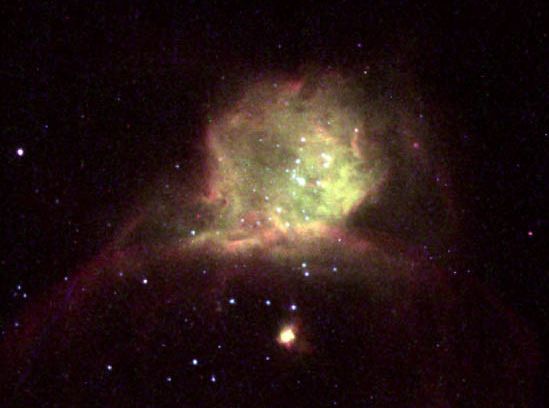Explanation: In nearby galaxy NGC 6822, this glowing emission nebula complex surrounds bright, massive, newborn stars. A mere 4 million years young, these stars condensed from the galaxy's interstellar gas and dust clouds. The nebular glow is powered by the bright stars' intense ultraviolet radiation while its shape is sculpted by the interaction of stellar winds and radiation with the immense interstellar clouds themselves. Cataloged as Hubble-X, many skygazers find the appearance of this extragalactic star forming region reminiscent of the most famous stellar nursery in our own galaxy, the Orion Nebula. Hubble-X is intrinsically much brighter than Orion though, and at a distance of 1.6 million light-years it is about 1,000 times farther away. Hubble-X is also about 100 light-years across compared to 10 light-years for the Orion Nebula. Why is it called Hubble-X? X is the Roman numeral 10, this nebula's designation in a catalog of similar objects for galaxy NGC 6822.
1999 2000 2001 2002 2003 2004 2005 2006 2007 2008 2009 2010 2011 2012 2013 2014 2015 2016 2017 2018 2019 2020 2021 2022 2023 2024 2025 |
Yanvar' Fevral' Mart Aprel' Mai Iyun' Iyul' Avgust Sentyabr' Oktyabr' Noyabr' Dekabr' |
NASA Web Site Statements, Warnings, and Disclaimers
NASA Official: Jay Norris. Specific rights apply.
A service of: LHEA at NASA / GSFC
& Michigan Tech. U.
|
Publikacii s klyuchevymi slovami:
nebula - zvezdoobrazovanie - star formation - hubble-x - NGC 6822 - Habbl-X - tumannost'
Publikacii so slovami: nebula - zvezdoobrazovanie - star formation - hubble-x - NGC 6822 - Habbl-X - tumannost' | |
Sm. takzhe:
Vse publikacii na tu zhe temu >> | |
